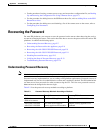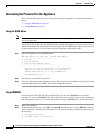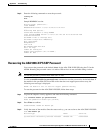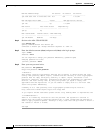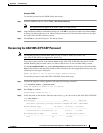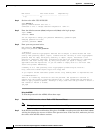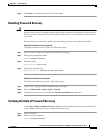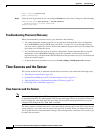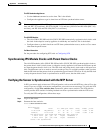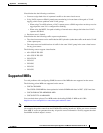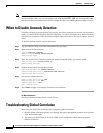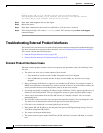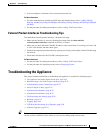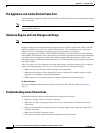
E-15
Cisco Intrusion Prevention System Appliance and Module Installation Guide for IPS 7.1
OL-24002-01
Appendix E Troubleshooting
Time Sources and the Sensor
The IPS Standalone Appliances
•
Use the clock set command to set the time. This is the default.
•
Configure the appliance to get its time from an NTP time synchronization source.
Note
The currently supported Cisco IPS appliances are the IPS 4240, IPS 4255, and IPS 4260 [IPS 7.0(x) and
later and IPS 7.1(5) and later], IPS 4270-20 [IPS 7.1(3) and later], IPS 4345 and IPS 4360 [IPS 7.1(3)
and later], and IPS 4510 and IPS 4520 [IPS 7.1(4) and later].
The ASA IPS Modules
•
The ASA 5500-X IPS SSP and ASA 5585-X IPS SSP automatically synchronize their clocks with
the clock in the adaptive security appliance in which they are installed. This is the default.
•
Configure them to get their time from an NTP time synchronization source, such as a Cisco router
other than the parent router.
For More Information
For the procedure for configuring NTP, refer to Configuring NTP.
Synchronizing IPS Module Clocks with Parent Device Clocks
The ASA IPS modules (ASA 5500-X IPS SSP and ASA 5585-X IPS SSP) synchronize their clocks to
the parent chassis clock (switch, router, or adaptive security appliance) each time the IPS boots up and
any time the parent chassis clock is set. The IPS clock and parent chassis clock tend to drift apart over
time. The difference can be as much as several seconds per day. To avoid this problem, make sure that
both the IPS clock and the parent clock are synchronized to an external NTP server. If only the IPS clock
or only the parent chassis clock is synchronized to an NTP server, the time drift occurs.
Verifying the Sensor is Synchronized with the NTP Server
In IPS, you cannot apply an incorrect NTP configuration, such as an invalid NTP key value or ID, to the
sensor. If you try to apply an incorrect configuration, you receive an error message. To verify the NTP
configuration, use the show statistics host command to gather sensor statistics. The NTP statistics
section provides NTP statistics including feedback on sensor synchronization with the NTP server.
To verify the NTP configuration, follow these steps:
Step 1
Log in to the sensor.
Step 2
Generate the host statistics.
sensor# show statistics host
...
NTP Statistics
remote refid st t when poll reach delay offset jitter
11.22.33.44 CHU_AUDIO(1) 8 u 36 64 1 0.536 0.069 0.001
LOCAL(0) 73.78.73.84 5 l 35 64 1 0.000 0.000 0.001
ind assID status conf reach auth condition last_event cnt
1 10372 f014 yes yes ok reject reachable 1
2 10373 9014 yes yes none reject reachable 1
status = Not Synchronized



